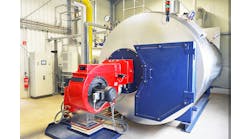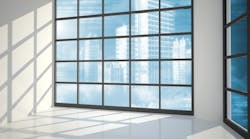In the previous two articles, I addressed the application of radiant windows for typical comfort related applications, with an emphasis on human comfort. There is also a need for atypical applications, some comfort related, and some not.
Non-comfort related applications are typically concentrated around the elimination of snow on large expanse glazing systems. For example, many fast food restaurants will have a “lean-to” style of greenhouse added to the side of their primary structure to give the feeling of dining al fresco. The energized glass can be configured in two positions on a typical double-pane window. When the glass industry talks about glazing in multiple layer considerations, they assign surface numbers to the panes, beginning with the outside layer. So, the outer most pane of glass on a typical double pane window would be Surface number 1, and the inner most surface would be Surface number 4. On a triple-pane window, the innermost layer would be Surface number 6.
In the case of the lean-to glass structure, if there were a pedestrian walkway near the bottom edge of the lean-to glazing system serving the greenhouse, in areas with significant snowfall potential, it’s conceivable that you could have an inadvertent avalanche when the accumulated snow decides to slide off of the windows. If a person happens to be anywhere near this event, they are exposed to the real possibility of being completely inundated by falling snow and ice, possibly resulting in personal injury. Worse still, they could be knocked into the driveway. Trust me, it happens.
At present, the restaurant operator will barricade the walkway near the slide zone to avoid the possibility of one of his patrons getting covered by falling ice and snow. This may, in certain cases, force the pedestrian to have to take a different, more dangerous route to his parked vehicle or to public transportation. If the operator forgets to barricade the walkway, and a pedestrian is hit by snow falling from the glass, he is exposed to liability that can be avoided with the proper application of thermally dynamic glass to melt the snow as it falls, instead of allowing it to accumulate and slide off.
In this application, Surfaces 2 and 3 could be independently energized and controlled to deliver excellent human comfort on the inside of the greenhouse, while also protecting pedestrians and the sidewalk on the outside by eliminating the possibility of snow and ice sliding off of the lean-to glazed structure.
It would be much less energy intensive to provide a partially enclosed glass structure, and maintain human comfort by keeping the inner glass surfaces at a temperature that will keep the occupants inside comfortable
Wattage density of the glass can be adjusted to avoid the short-cycling syndrome typically associated with mechanical equipment. In this case, during less than peak loads, the watt density can be further limited by configuring a pulse width modulation control logic. In the case of the internal glazing (Surface 3 energized, Surface 4 is the emitter) we are only inducing enough energy to maintain the glazing in a “thermally neutral” condition. In other words, we only want to keep the internal glazing at a temperature of around 70°F. Thqt temperature is just warm enough that the 20,000 sensors imbedded in the typical human body can’t “see” the glazing as feeling cold. At all times during the cooling season, the glazing is completely de-energized.
In the case of the external glazing, we configure the glass to have around 44 watts per square foot (equal to 150 Btu/sq.ft./hour) in an effort to maintain the outer glass surface at a temperature of around 36°F to 40°F at outdoor “design” conditions. We do this by inducing current into Surface 2, with Surface 1 being the final emitter. If the glazing is single-pane high-strength glass, like is typically used for structural glass canopies over building entrances, the energized glass is laminated to the structural glazing system and current is induce into Surface 3, which is in intimate contact with Surface 2, thereby forcing the majority of the energy to the outer glass, avoiding the accumulations of snow and ice.
Control of the snow-melting surfaces is done using off-the-shelf snow and ice melt controls. The outer surface is only energized if the glass surface is below 35°F, and moisture is being sensed in the form of rain or snow, with an ambient temperature below 32°F. It is entirely possible to program an “anticipation” capability with today’s intelligent controls.
Many casinos have begun requiring smokers to stop smoking on the inside of the building. To accommodate their tobacco needs, the casinos are providing the smokers with heated smoking porches on the outside of the building. This is typically done by using a high-watt, high-intensity heating element with a reflective shield to direct the radiant energy downwards towards the smokers.
It would be much less energy intensive to provide a partially enclosed glass structure, and maintain human comfort by keeping the inner glass surfaces at a temperature that will keep the occupants inside comfortable, regardless of the surrounding ambient conditions. This will require a watt density that is higher than the typical internal application, but it is much easier to control. The overall watt density of the smoking structure would still be lower than the high-intensity heat lamps, and the shelter would provide a higher degree of user comfort.
In some airport shuttle parking facilities, the waiting shelters will have an electric forced-air heating unit. These structures are typically open air and, if there is a slight breeze, the induced energy in quickly lost to the winds, creating a major waste of energy with little to no human comfort provided. If radiant glass is applied in these situations, it would only operate if the ambient air temperature were low enough, and human occupancy was sensed using off-the-shelf infrared motion detectors. Again, this would result in a significant reduction in energy consumption to keep the waiting occupants comfortable. The same applies to heated bus and train waiting facilities.
This completes my series of article on the applications of thermally dynamic energized glass. In my professional opinion, if properly applied, these devices will provide significant increases in human comfort, and reduce the energy consumption associated with their application. For more information, visit www.IQradiantglass.com.
Tune in next month as we look at the winners of this year’s biennial Department Of Energy Solar Decathlon contest held in Denver, Colorado. Until then, Happy Energized Glass hydronicing.
Mark Eatherton material, in print and online, is protected by Copyright 2017. Any reuse of this material (print or electronic) must first have the express written permission of Mark Eatherton and CONTRACTOR magazine. Please contact via email at [email protected]


